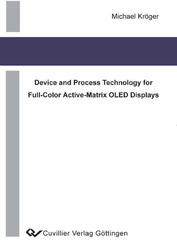| Departments | |
|---|---|
| Book Series (96) |
1378
|
| Nachhaltigkeit |
3
|
| Gesundheitswesen |
1
|
| Humanities |
2362
|
| Natural Sciences |
5406
|
| Mathematics | 229 |
| Informatics | 319 |
| Physics | 980 |
| Chemistry | 1363 |
| Geosciences | 131 |
| Human medicine | 243 |
| Stomatology | 10 |
| Veterinary medicine | 108 |
| Pharmacy | 147 |
| Biology | 835 |
| Biochemistry, molecular biology, gene technology | 121 |
| Biophysics | 25 |
| Domestic and nutritional science | 45 |
| Agricultural science | 1004 |
| Forest science | 201 |
| Horticultural science | 20 |
| Environmental research, ecology and landscape conservation | 148 |
| Engineering |
1790
|
| Common |
97
|
|
Leitlinien Unfallchirurgie
5. Auflage bestellen |
|
Advanced Search
Device and Process Technology for Full-Color Active-Matrix OLED Displays (English shop)
Michael Kröger (Author)Preview
Table of Contents, Datei (79 KB)
Preface, Datei (84 KB)
Extract, Datei (260 KB)
Organic light emitting diodes fascinate due to unique properties like an extremely thin design, wide viewing angle and low energy consumption. For these reasons, OLED technology appears to be a promising technology for high-end display units. Today, organic light emitting diodes are already applied for low resolution applications as – for instance – mobile phone and automotive sub-displays. For being a serious competitor the high-resolution large-area display market, active-matrix driving circuits have to be integrated onto the display substrate. Since the circuitry is most likely to be opaque, the light has to be emitted rather from the top than through the substrate. This is, where inverted organic light emitting diodes step into the spotlight. The term “inverted” refers to a reversed deposition sequence compared to conventional bottom-emitting OLEDs. Up-scaling of laboratory deposition processes to high-volume production means further challenges on the way to commercial full-color AM-OLED displays. The present study focuses on the realization of highly efficient IOLEDs and the development of scalable deposition and patterning processes.
Utilizing highly phosphorescent emitter materials boosts the efficiency of inverted IOLEDs. As a precondition, luminescence quenching via thermal recrystallization of the host material, energy transfer to image dipoles on the cathode’s surface or radiationless decay of interfacial exciplexes has to be minimized by an optimized device structure. Combining the optimized device structure with doped charge injection layers, yields superb efficiencies of 59 cd/A and 21 lm/W as well as a maximum brightness of 100000 cd/m². Coupling of several emission units by so called charge generation layers (CGL) enables a further increase of the current efficiency. An inverted OLED with two EMUs reaches a current efficiency of up to 92 cd/A. Effective CGL-structures are made of a pn-heterojunction of at least 5 nm thick 1-TNATA:F4-TCNQ/BPhen:Li layers. The mechanism is explained as tunneling through a narrow depletion zone at the pn-interface.
Sputtering of ITO on top of the sensitive organic layers is performed at room temperature and low intensity to prevent from sputter induced damage of the organic layers. When mixing a small fraction of oxygen into the argon sputtering atmosphere, an electric conductivity of about 2300 S/cm and an optical transparency of 85 % can be achieved.
For enabling the deposition of phosphor-doped emission layers within an inline system, a prototype co-evaporation source is used. As the outlet hole for both materials are aligned on a common axis, ideal superposition of the sublimation beams is possible. The thickness uniformity across a 100 × 120 mm² large substrate was nearly +/- 5 % of the average.
So far, micropatterning of organic materials was performed by shadow masking, which is certainly limited to medium substrate sizes. The laser induced local transfer (LIL) is presented as possible patterning technology for large substrate sizes. The dependence of the pattern resolution on the process parameters is given by an approximated model description. Minimum feature sizes of about 60 µm are achieved.
| ISBN-13 (Printausgabe) | 3867274215 |
| ISBN-13 (Hard Copy) | 9783867274210 |
| ISBN-13 (eBook) | 9783736924215 |
| Final Book Format | A5 |
| Language | English |
| Page Number | 138 |
| Edition | 1 |
| Volume | 0 |
| Publication Place | Göttingen |
| Place of Dissertation | Braunschweig |
| Publication Date | 2007-11-19 |
| General Categorization | Dissertation |
| Departments |
Informatics
Physics Electrical engineering |








